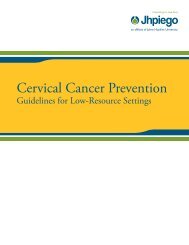Manual for Male Circumcision under Local Anaesthesia
Manual for Male Circumcision under Local Anaesthesia
Manual for Male Circumcision under Local Anaesthesia
You also want an ePaper? Increase the reach of your titles
YUMPU automatically turns print PDFs into web optimized ePapers that Google loves.
<strong>Male</strong> circumcision <strong>under</strong> local anaesthesia<br />
Version 3.1 (Dec09)<br />
When disposing of the sharps container:<br />
Step 1. Wear heavy-duty utility gloves.<br />
Step 2. Cap, plug, or tape the opening of the container tightly closed.<br />
Make sure that no sharp items are sticking out of the container.<br />
Step 3. Dispose of the sharps container by burning, encapsulating, or<br />
burying it.<br />
Step 4. Remove utility gloves.<br />
Step 5. Wash hands and dry them with a clean cloth or towel or allow<br />
to air-dry.<br />
Burning waste containers<br />
Burning destroys the waste and kills any microorganisms, and is the<br />
best method of disposing of contaminated waste. It reduces the bulk<br />
volume of waste and also ensures that items cannot be scavenged<br />
and reused.<br />
Encapsulating waste containers<br />
Encapsulation is the easiest way to safely dispose of sharps<br />
containers. When the container is three-quarters full, pour cement<br />
(mortar), plastic foam, clay or other similar material into the container<br />
until it is completely full. After the material has hardened, seal the<br />
container and dispose of it in a landfill or bury it.<br />
.<br />
Burying waste<br />
In health care facilities with limited resources, burial of waste (such<br />
as excised <strong>for</strong>eskins) near the facility may be the only practical<br />
option <strong>for</strong> waste disposal. To limit health risks and environmental<br />
pollution, some basic rules should be followed:<br />
• Restrict access to the disposal site. Build a fence around the<br />
site to keep animals and children away.<br />
• Line the burial site with a material of low permeability (e.g.,<br />
clay), if available.<br />
• Select a site at least 50 meters away from any water source<br />
to prevent contamination of the water table.<br />
• Ensure that the site has proper drainage, is located downhill<br />
from any wells, is free of standing water, and is not in an area<br />
that floods.<br />
Prevention of Infection Chapter 8-15
















